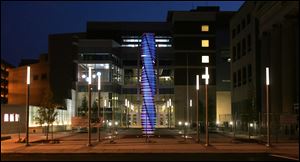
Arena debt not a concern for now, county officials say
6/14/2010
Huntington Center was targeted to hold 87 events this year and has had 62 so far. Officials hope that's a sign of future success.
Lucas County's gleaming new Huntington Center arena has been a crowd-pleaser thus far with Walleye fans and concert-goers, as well as with downtown Toledo's rebounding restaurant and tavern establishments.
But in this age of underwater mortgages and ever-mounting budget deficits, will the county have trouble paying off the debt on its $98 million investment in bricks, mortar, and hockey ice?
According to the county's fiscal stewards, that shouldn't be a problem.
"Things right now are looking good," said John Zeitler, county budget director. And helping out the county are lower-than-projected construction expenses and favorable borrowing costs.
''The first year of Toledo Walleye hockey went quite well, as attendance exceeded our projections. We anticipate having very good news when our fiscal year ends,'' said Joe Napoli, president and general manager of the Walleye and the Mud Hens. He also heads Toledo Arena Sports.
The total cost of the arena dropped recently to $98.1 million from an earlier $105 million estimate, thanks to unneeded contingency funds and lower prices for construction materials as the economy weakened, said Bridgette Kabat, chief of staff for the Lucas County commissioners.
That former price tag followed a much earlier $85 million estimate established before architects expanded the arena. The 8,000-seat facility opened in October.
The county is also benefiting from relatively low interest rates as it issues a total of $86 million in bonds and notes.
It sold a portion of bonds in late May - $19.1 million in taxable and $48.8 million in tax-exempt bonds - and anticipates selling the notes in mid-July.
Those bonds were purchased by Stifel Nicholaus and Co., a St. Louis-based broker-dealer. The firm also bought the short-term "bond anticipation notes" the county issued in both 2008 and 2009 as it waited for a good time to sell the project's big 30-year bonds.
The county carries an AA2, or high-grade, bond rating from Moody's Investors Service.
By opting to go with short-term debt when interest rates were higher two years ago and then locking in the lower rates now, the county ultimately saves money, officials said.
"You swing a percentage, and over 30 years, that's millions of dollars," Mr. Zeitler said.
Interest rates on the just-sold bonds start low and gradually rise, averaging 4.5 percent on the tax-exempt bonds and 6 percent on taxable bonds.
To pay the tax-exempt debt, officials are keeping a close eye on who's getting shut-eye in the county's hotels and motels.
Those bonds and notes are to be paid off with revenues from the hotel/motel tax, which was increased 2 percent in March, 2008, for that very task.
County officials concede that the hotel/motel tax, now 10 percent, is collecting less per year than the $5.2 million anticipated before the recession.
But the $4.1 million projected for 2010 is still enough to do the job, because $3.7 million is about the bare minimum needed to make the debt payments, the officials said.
"We made sure that we mitigated as much risk as possible," Ms. Kabat said.
Yet few investments are risk-free. If revenues fall to unforeseen levels, the county would have to dip into its reserves to prevent a debt default - similar to how the city of Toledo now pays about $1 million a year for three underperforming apartment projects for which it once sold bonds.
"The ultimate risk, the bottom line, is the county general fund," Mr. Zeitler said. "But that's never happened with Fifth Third Field and we don't think it will happen with this."
The project's taxable bonds and notes are to be paid off with multiple streams of revenue, including proceeds from the naming-rights deal with Huntington National Bank, gate and concession receipts, and sales of suites and corporate sponsorships.
Mr. Zeitler said the county must pay $4 million a year for the first four years of the bond's life; then the debt service drops to about $1.8 million annually.
This strategy will make payment lest costly for the county in the long run.
"We're going to load up that debt schedule more up front and less later on," Mr. Zeitler said, noting how the county gets some up-front cash in the initial six-year, $2.1 million naming-rights deal with Huntington.
Steve Miller, general manager for the arena's management company, SMG, said the county can expect extra revenue from Huntington Center this year because of strong ticket sales. The arena was budgeted for 87 events in 2010 and has had 62 already, including concerts by Elton John and Carrie Underwood.
"Overall, the arena is doing very well and has exceeded our expectations," Mr. Miller said. "We've been very pleased with the events we've been able to get and the tickets we've been able to sell."
Yet a crucial piece of funding not in hand is what the county sees as its full share of state money.
The Ohio Cultural Facilities Commission has approved just $7.7 million of the $14.4 million the county is banking on.
"We received verbal guarantees from our state legislators that they fully intend to fully fund it; it's just going to be over a couple capital cycles," Ms. Kabat said, referring to several years' time.
Contact JC Reindl at:
jreindl@theblade.com
or 419-724-6065.